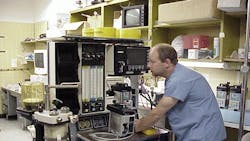Biomedical Sector in China Receives Support to Tune of $160 Billion
In an effort to move from a manufacturing base to an innovation hub, China is investing billions of dollars in its biomedical sector.
The R&D investments – reaching a cumulative $160 billion last year and close to surpassing Japan’s spending – are paying off with exponential increases in pharmaceutical-related patent filings, catapulting China past the United States and Japan, according to Lux Research.
“Rising income levels and a shifting demographical landscape are creating a faster growing market space for innovative biomedical products in China,” said Kevin Pang, Lux Research Director .
Also, the pace of establishment of 15 new drug innovation centers and clusters is remarkable, with super clusters forming around five major provinces
“While the Chinese domestic market provides ample room for all players now, Chinese pharmaceutical companies will naturally look outside to lucrative markets in North America and Japan over time,” he added.
Lux Research analysts examined the state of China’s biomedical sector, with particular attention to its R&D. Among their findings:
Sustained investment is key to rapid growth.China’s drive to innovate is fueled by sustained, and ever-increasing, funding. With cumulative funding reaching $160 billion in 2012, China is poised to overtake Japan and become the second-largest R&D spender in the world, behind the U.S. Also, biomedical research has emerged as a focus area with funding shifting from traditional basic research to greater emphasis on commercialization.
MNDIP drives innovation.Started in 2009, the Major New Drug Innovation Program (MNDIP) has emerged as the source of innovation in China, producing over 3,000 patents and 12 products. With funding of over $4.5 billion by 2012, China has set ambitious goals of developing 30 new innovative drugs and powering 200 drugs to sales over RMB 100 million (US$ 17 million). It is targeting 100 innovative new drugs to be discovered by 2020.
Special focus on cancer. Oncology has received the most attention – 56 of the 127 MNDIP projects seek to develop drugs to treat cancer, which is now the leading cause of death in China. Biologics outweigh small molecule drugs by a large margin – 34 for developing biologics versus only 22 for developing small molecule drugs.
Timely changes to patent law spurs growth.Chinese pharmaceutical’s rapid growth has been aided by timely changes in patent and related laws since 1992 when the nation joined the TRIPS (Trade-Related aspects of Intellectual Property rights) agreement. A latest revision has made biomedical patent protection truly enforceable, and is sure to act as a stimulus to further innovation.
